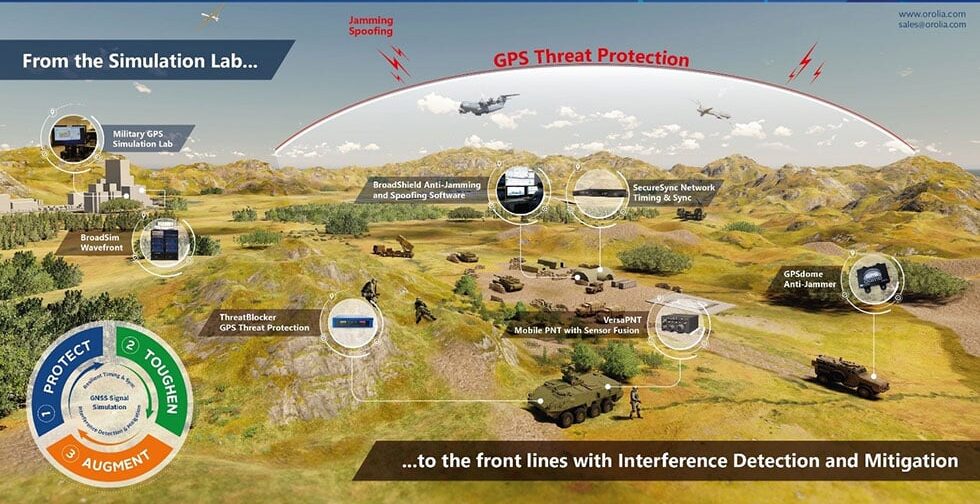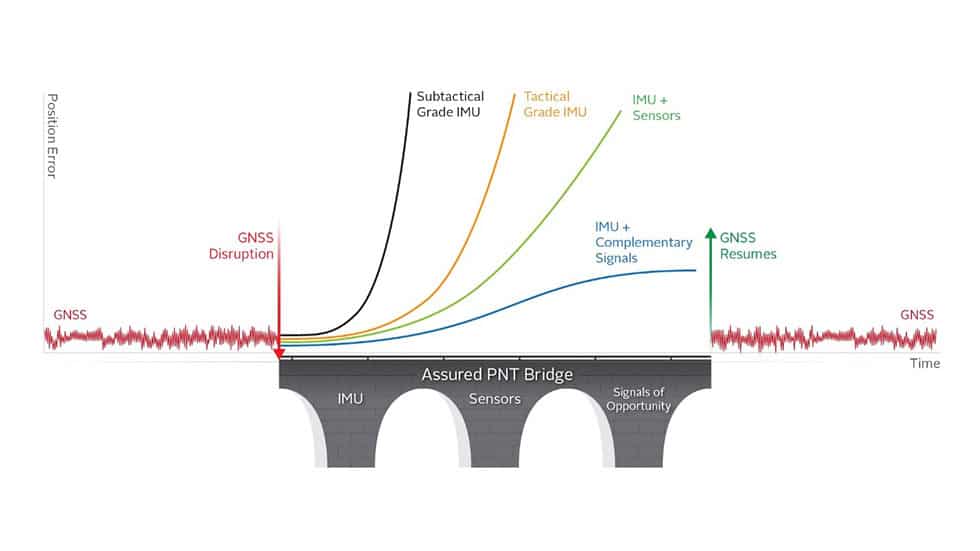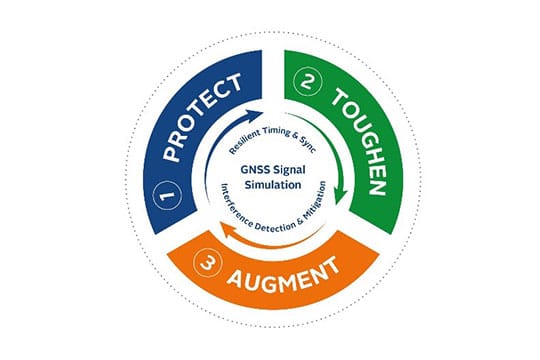Simulation & IDM: Protecting GPS Signals and PNT Data
How can you protect critical systems from interference, jamming and spoofing?
These days, it’s easier than ever to disrupt GPSGlobal Positioning System is a navigation satellite system. See also/GNSS signals and systems that rely on accurate Positioning, Navigation and Timing (PNTPosition, Navigation, and Timing: PNT and map data combine to create the GPS service.) data — and nearly every critical system around the world depends on these signals and data. When it comes to military systems, failure isn’t an option. How can you protect essential systems from interference and denial of service attacks?
Protect, Toughen and Augment. These strategies are key to achieving a robust Simulation and Interference Detection and Mitigation (IDM) solution. But what do these words really mean for your GNSSGlobal navigation satellite system (GNSS): A general term describing any satellite constellation that provides positioning, navigation, and timing (PNT) services on a global or regional basis. See also and PNT-reliant systems? How exactly does Simulation & IDM protect you from intentional or unintentional interference? How can you create a Resilient PNT solution?
Your first priority is to Protect. To protect a critical system, you must first assess where it is vulnerable. GNSS Simulation shows how your system will react in a variety of scenarios, so that when the GNSS signal or PNT data is threatened, you’re ready with backups and countermeasures to ensure continuous operations.
For both military and commercial systems, testing and simulation should not be a one-time thing. Regular testing is essential for known anomalies, such as GPS week rollovers, as well as the latest jamming and spoofing threats. As new threats emerge, potential scenarios should be added to your testing protocols. Here’s what GNSS testing and simulation can reveal:
- How does my critical system react to GNSS signal and PNT data disruption?
- How do I know if it’s being jamming or spoofed? How quickly will I be notified?
- How does the system respond to threats?
- How can my system be compromised, and how can I prevent it?
The goal is to validate how your military system will perform before you put warfighters, weapons and critical resources in compromised environments. Simulation and testing should always occur first, and it should be ongoing. Safran offers a wide range of GNSS Simulation options depending on your needs.
With testing and simulation results in hand, you can develop a plan to Toughen. That’s the beginning of IDM.

Prepare for NavWar and GPS-Denied Environments
IDM solutions include customized strategies and tactics to maintain the integrity of GNSS signals and PNT data for battlefield readiness. Since most military systems rely on GNSS signals, those systems must be toughened to withstand jamming and spoofing threats. Resiliency in compromised environments is paramount to ensure mission success and protect assets and personnel.
Safran offers several categories of IDM solutions:
- Anti-Jam Antennas – your first line of defense against a GNSS signal interruption. An adaptive antenna, or Controlled Radiation Pattern Antenna (CRPA), can offer very high levels of jamming resistance but they are large, heavy and expensive. For airborne platforms, conformal antennas can be used. For the dismounted warfighter, the trend is toward wearable solutions such as GPSdome. For fixed site locations, Safran offers the 8230AJ anti-jam antenna to block interference at the horizon, where most interference comes from.
- Anti-Jammer – GPSdome is a small, add-on device that ensures continuity of navigation and operations during jamming conditions, and the industry’s first non-ITAR anti-jammer.
- Jamming and Spoofing Detection – software that identifies threats in real time. BroadShield is available as a software solution or as part of Safran’s SecureSync, VersaSync and VersaPNT Resilient PNT solutions.
- Jamming and Spoofing Suppression – SecureSync with BroadShield enables users to detect and characterize GNSS jamming and spoofing threats. Built into the SecureSync time and frequency platform are LED status indicators for real-time awareness, and an intuitive web user interface to view real-time and historical data. This system can easily be paired with a CRPA solution such as the GPS Dome, to provide resiliency and protection against GPS Jamming and Spoofing threats.
- GNSS Translation – Safran’s patented Simulation GNSS translation scheme [US patent 10,241,211] will take the output from a protected GNSS receiver and re-create a clean GNSS signal for radiation in an area in any format. A typical use case is distributing M-Code derived Assured PNT information from a protected receiver to older SAASM or commercial receivers in a targeted area. The older, unprotected receivers obtain the same protection benefits as the M-Code receiver via this clean, translated signal.
After you’ve protected and toughened your system, the next step is to Augment. An effective augmentation strategy ensures the continuity of data from the time of GNSS signal or PNT data disruption until access is restored. It serves as a bridge from the loss of your signal to the time you get it back. Many variables factor into the specifications to build that bridge – for example, how long you’re able to operate without a GNSS signal and the level of positioning accuracy needed to maintain a sufficient level of situational awareness. The chart below shows some of these variables based on the type of IMUAn IMU or Inertial Measurement Unit is an electronic device that measures the heading and orientation and velocity of a vehicle. It contains both an accelerometer and a gyroscope to provide necessary data to maneuver an aircraft or spacecraft, especially when GPS signals are not available. (inertial measurement unit) you use and the presence of sensors or alternate signals

Your IMU is self-sufficient. It does not rely on external signals that can be jammed or spoofed, but uses internal accelerometers and gyroscopes to sense movement. However, even the most accurate IMU has some error or “drift,” so in the absence of GNSS, the error will grow exponentially. How you deal with that drift — how you augment your signal — depends on your requirements. If you need very high accuracy for a short period of time, you can go with a sub-tactical grade IMU. If you need more accuracy over a longer period, you need a tactical grade IMU. If you add sensors like an odometer, you get longer usable PNT data for a longer period, and an IMU coupled with a complementary signal gives you the longest protection.
The most effective Resilient PNT solutions can provide accurate protection indefinitely. Alternate, encrypted signals are recommended for this level of protection. Typically, these signals are not as accurate as GNSS, but they are often stronger and more jam resistant. Encrypted signals are available from subscription-based services or through secure military signals. So, by using an alternate, encrypted signal to augment the IMU derived position, drift error can be limited indefinitely to nearly GNSS accuracy.
Sensor fusion is another way to augment your system. Sensor fusion combines multiple signals of opportunity and sensors, feeds them into one engine and delivers accurate positioning information. A sensor fusion solution such as VersaPNT uses algorithms to develop the best positioning data. Think of it as a battlefield hub that can include:
- GNSS
- Alternate signals
- LIDAR
- Radar
- Pseudolites
- MEMSMicroElectroMechanical System. See also sensors
- Cameras, and more
Combining data from multiple sensors corrects for the deficiencies of individual sensors to calculate accurate position and orientation information.
Bringing It All Together
GNSS jamming and spoofing are on the rise. Almost daily, the media reports new incidents in the air, on land and at sea. Even a $50 truck jammer can cause potentially devastating effects to a GNSS system, risking mission failure or loss of life. Simulation and IDM provide a practical, complementary approach to ensuring battlefield readiness, protecting military systems and staying ahead of enemy forces. Safran is the world leader in Resilient PNT and complementary Simulation/IDM solutions. When failure isn’t an option, trust Safran to protect your critical systems. To learn more, contact simulationsales@nav-timing.safrangroup.com.


